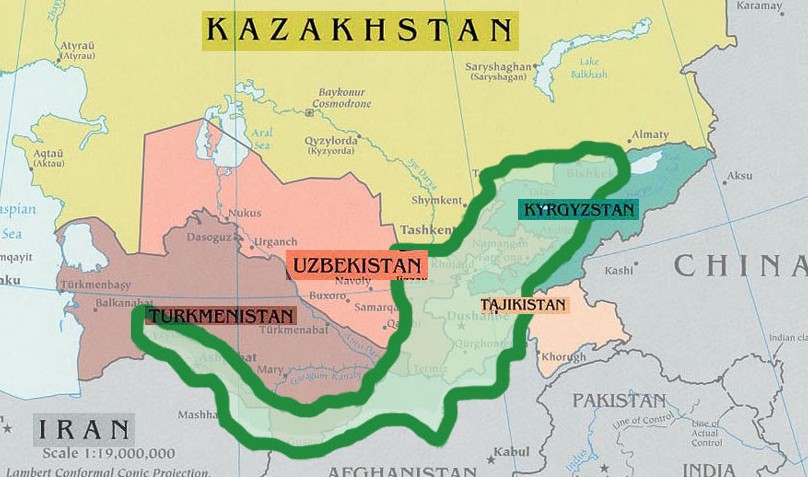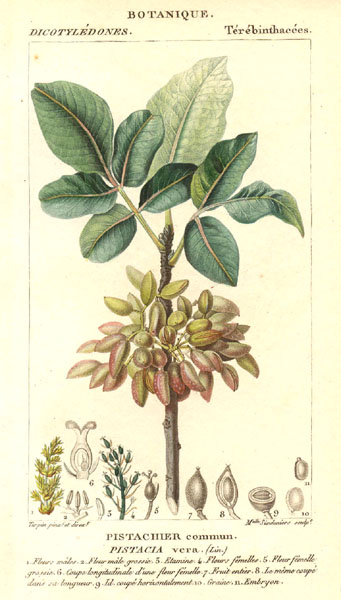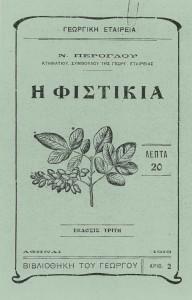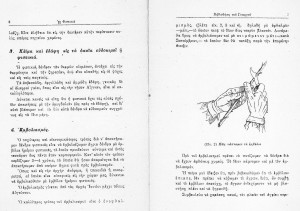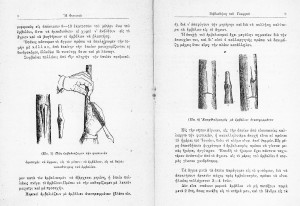Where pistachios originated
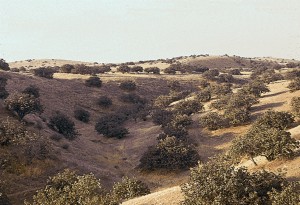
Until the late 19th century the exact place of origin of pistachios was not known. At the end of the 19th century European botanists on a visit to the Middle East who saw the extensive pistachio plantations put forward the view that they came from Syria, Turkey and/or Mesopotamia. But in 1929-1930 Russian botanists on a visit to Central Asia found pistachio trees growing wild in vast expanses of the mountains and the plains, forming a kind of forested steppe on terrain of poor ecological composition. The region where wild pistachio trees were growing extended over Northern Iran, Northern Afghanistan, Northern Turkmenistan, Eastern Uzbekistan, Tajikistan, and into Kyrgyzstan. It is to be concluded from this that Central Asia is the place of origin of the wild ancestor of today’s cultivated pistachio.
The pistachio tree in the Old Testament
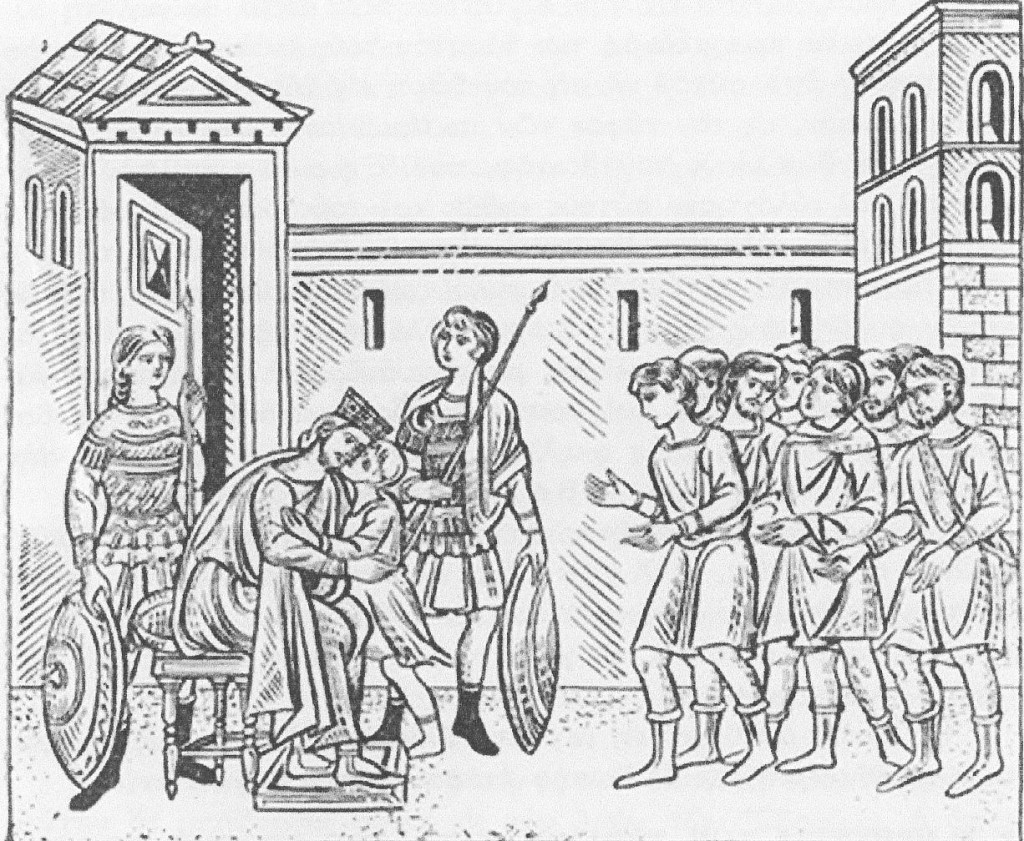
Sicilian scholars have developed the theory that the pistachio tree was cultivated in Palestine in the time of Jacob, a hypothesis with textual support from the Old Testament. Chapter 43 of the book of Genesis speaks of a great famine in the land. The reference is to the seven years of hunger. There was grain in Egypt, where following Joseph’s advice corn had been stored in large quantities to cover the need for food during the seven years of hunger. Jacob then told his sons to go Egypt to buy food and bring it back to Canaan. He also counseled them to take with them, together with the silver, some of their country’s finest products: a little balsam, honey, perfumes and myrrh, walnuts and pistachios (“botnim”). These they were to offer as presents to Joseph.
First description of the pistachio tree in the Greek language
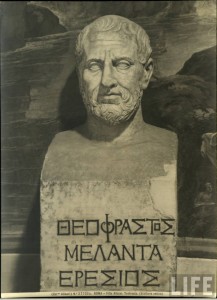 The first writer to refer to the pistachio tree in the Greek language, and to describe it, was Theophrastos of Eresos In his work “The natural history of plants” he gives the following description of the pistachio tree: “It is said that a tree grows there (in India) resembling the turpentine tree. This is true of the leaves, the branches and other features apart from the fruit, which is different and similar to almonds. This tree is also said to grow in Bactria. Its nuts are the same size as almonds and look like almonds, but their shell is not rough and in taste they are superior to almonds, which is why in this place they are preferred to almonds.” As far as we know Theophrastos never went to Asia. He took his description of the pistachio tree from one of the historians who followed Alexander the Great on his Asian expedition.
The first writer to refer to the pistachio tree in the Greek language, and to describe it, was Theophrastos of Eresos In his work “The natural history of plants” he gives the following description of the pistachio tree: “It is said that a tree grows there (in India) resembling the turpentine tree. This is true of the leaves, the branches and other features apart from the fruit, which is different and similar to almonds. This tree is also said to grow in Bactria. Its nuts are the same size as almonds and look like almonds, but their shell is not rough and in taste they are superior to almonds, which is why in this place they are preferred to almonds.” As far as we know Theophrastos never went to Asia. He took his description of the pistachio tree from one of the historians who followed Alexander the Great on his Asian expedition.
Τhe name “pistachio”
In his description of the pistachio tree Theophrastos does not give it a name. He says that Asian trees that are not to be found among the plants of Greece do not have names.
The first writer to use the word “pistakia” is the poet Nicander of Colophon (2nd century B.C.). Nicander also writes that “pistakia” are to be found in India and resemble almonds, adding that they have the quality of being able to protect one from scorpion bites. The word “pistakia” comes from the ancient Persian word “pista” meaning pistachio. This word is the root of the name for the pistachio in most languages: pistache (French), pistachio (English), pistashka (Russian), fustuk (Arabic).
Bringing the pistachio to the Mediterranean

In the 1st century A.D. Dioscorides Pedanius mentions that pistachios are produced in Syria and have pharmaceutical qualities. Dioscorides was the most distinguished pharmacologist of the ancient world. His book “Regarding Medical Matters” (De Materia Medica in the Latin translation) remained in use until the Middle Ages.
Pliny wrote in the 1st century A.D. that at the end of the reign of the Emperor Tiberius (around 30 B.C) the pistachio tree was introduced into Italy from Syria by Vittelius and the same year into Spain by Flaccus Pompeius..
In the 2nd century A.D. (131-200 ?) the famous Greek physician Galen of Pergamum mentions that the pistachios at Alexandria, and above all those at Verroia in Syria, are useful for the health of the liver.
In the 2nd century A.D. Athenaeus of Naucratis, who lived for the greater part of his life in Alexandria, in his work Deipnosophistai wrote that the pistachios that are served at the tables of the wise are produced in Syria and are exceptionally tasty.
Around 900 A.D. the Arabs took possession of Sicily from the Byzantines and introduced the cultivation of the pistachio, “grafting the wild ones to domesticate them” as it says in relevant texts.
Cultivation extended over a wide area on the slopes of Mount Etna, which possessed the ideal combination of volcanic soil and favourable climatic conditions.
The pistachio tree in Greece
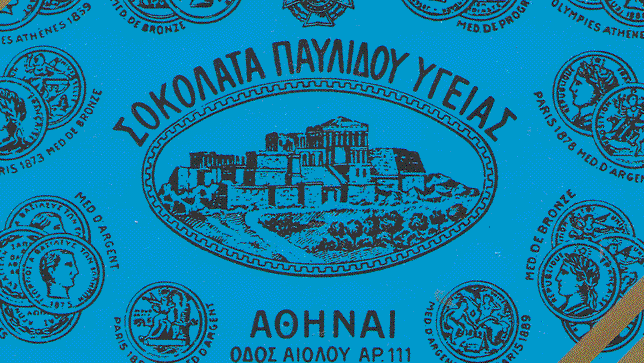
There are no references to pistachios in Greece before the 19th century.
In 1838 the French naturalist Bory de Saint Vincent writes that he saw pistachio trees in Figaleia and in Pylos. In 1856 pistachio trees were also to be seen in Zakynthos. These were however individual trees, not plantations.
In 1860 the chocolate industry importer D. Pavlidis established the first organized pistachio nursery on his estate at Psychico. In 1869 Orfanidis started cultivating pistachio trees at the Municipal Nursery. Gennadios, who succeeded him in 1882, continued his work.
After the Second World War the pistachio trees began to spread in Greece. There was a sudden great expansion in pistachio cultivation between 1950 and 1960. Today there are pistachio nurseries in all of Greece, north and south, and in the islands.
Aegina : the first references
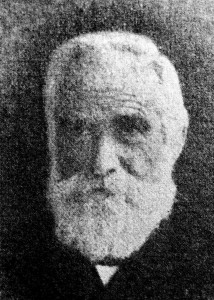
We know that the pistachio tree is closely connected with Aegina, but we don’t know exactly when it arrived on the island.
The famous German botanist Theodor von Heldriech vistited Aegina six times during the 19th century. In his work the “Flora of Aegina” he refers to all the native plants which were discovered by him and earlier botanists. He also noted the plants which were cultivated in different areas (vines, olives, cereals, vegetables etc). But he doesn’t mention the pistachio tree. However that doesn’t mean that there weren’t some individual trees in some gardens which escaped his notice.
There is a version which says that the pistachio tree came to Aegina from Persia in 1867. It is also worth noting that in the Kypraiou estate there were some very old trees which an ancestor had brought from Chios, towards the end of the 19th century. One of those trees still survives today.
Latterly, in Aegina’s historical archives, Anna Yiannoulis found a document which is a serious indication that there were fruit-bearing pistachio trees in Aegina in 1896. The document is a summons sent by one Konstantinos Tsoumas against Vasileous Granitsa. Tsoumas states that he delivered to Granitsa 12 ‘okades’ (one oka was 1.282 kilos until it was discontinued in 1959) of pistachios for him to sell on his behalf at 4 drachmas an oka. After Granitsa sold them he should therefore give Tsoumas his share of 48 drachmas. Even though Granitsa sold them he refused to give the money to Tsoumas. From the summons it appears that it is a simple local transaction and the amount of nuts mentioned could have come from one or two productive trees in a garden.
The first organised pistachio orchard
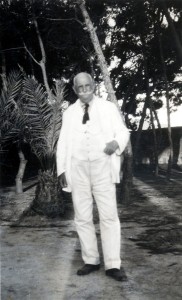
The first organised pistachio orchard in Aegina was established by Nikolao Peroglou in the area of Ag. Eirinas / Limbones, near the sea, in 1896. Peroglou had bought an area of around 20 stremmata (One stremma =1,000 square metres). The largest part of this estate was planted with various nut trees, among which were pistachios. The poor soil and the location near the sea meant that most of the trees didn’t flourish, with one notable exception: the pistachio trees. From then on he substituted all the other trees with pistachio trees.
The pistachio tree matures very slowly. When the trees had reached 12- 15 years of age, Peroglou saw that the pistachio was a tree with few needs and that the nuts sold for a good price. The dried pistachio nuts sold for 3 – 4 drachmas an oka, at a time when bread cost 75 lepta (there were 100 lepta in a drachma) an oka. Moreover, he realised that the climate and soil in Aegina were suitable for the tree’s development .
So he decided to dedicate himself to the cultivation of pistachio trees. In 1916 he published a small book entitled “The Pistachio Tree” which describes everything that the cultivation of the pistachio tree needs. It prompted the Aeginitans to plant pistachio trees, he shared cuttings from his best trees and when he wanted to give a present, he would give a pistachio tree sapling. There are still two such pistachio tree presents flourishing in Aegina.
The decade 1910 – the first cultivators
Peroglou, according to those who knew him, was very persuasive when he was trying to get landowners to cultivate pistachio trees. However, it’s not always easy for a landowner to abandon his traditional crops to plant a tree which they don’t know well. Which is the reason that the spread of the pistachio tree was very slow to start with.
Those who first copied Peroglou’s example were some Athenian friends who had estates or orchards in Aegina and had the financial wherewithal to do so. Among the first we find references to were: Alexandros Karapanos in Perivola; General Vasilakis Melas and his wife Eleni in Halikaki; G. Benizelos in Plakakia; and Panagiotis Giolman whose estate bordered on Peroglou’s.
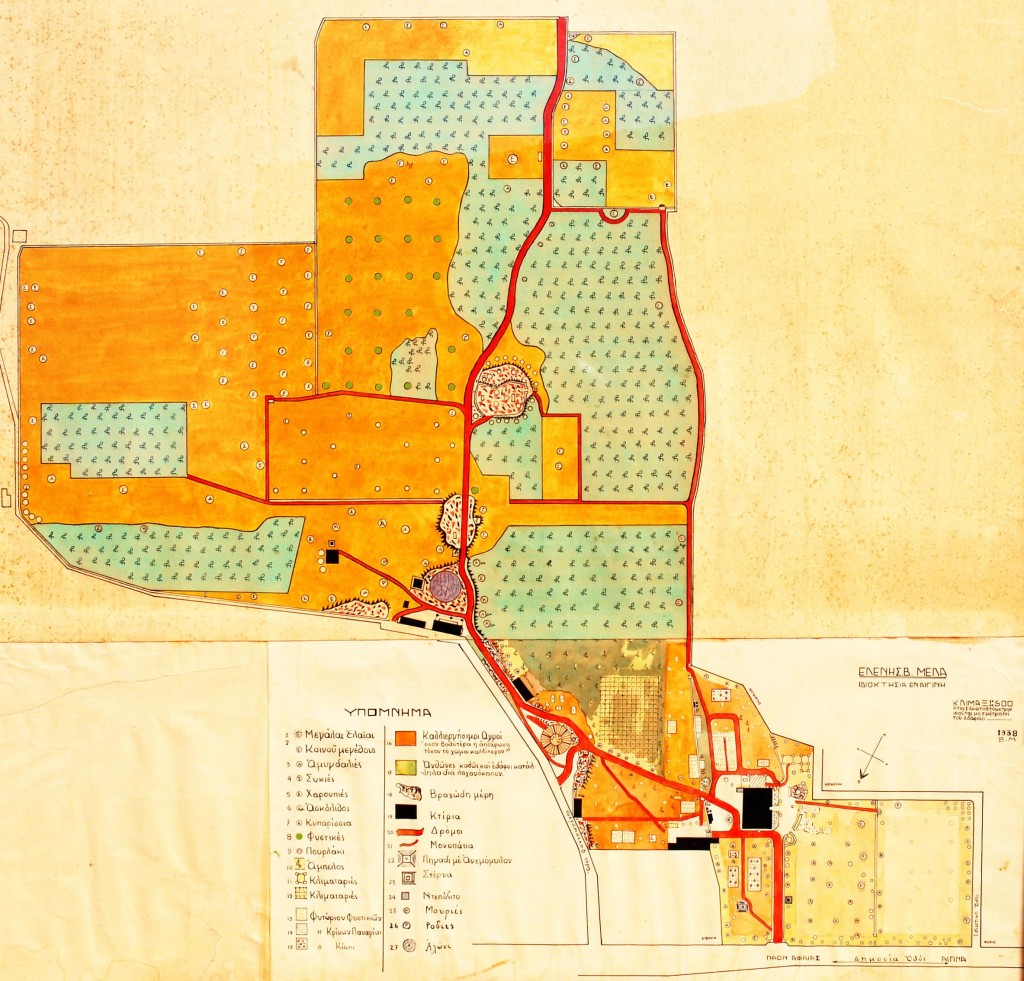
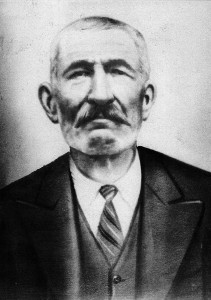
The Aiginitan farmers were more cautious. There were some however who were persuaded. Panagiotis Galaris, also a neighbour of Peroglou, planted pistachio trees and would eventually sell his first few pistachios in Syros to the makers of Turkish-delight.
In 1910 Eleni Haimanda (nee Alifandi) planted a few pistachio saplings in her garden at Faros. The trees which resulted were grafted and became the large trees which are still around today. Following her example, in 1915, her husband Nikolis Haimandas went to Chios to get seeds. That seed was used to create his own plant nursery so that he could plant pistachio trees on his large estates. The newsaplings he then planted in his vineyards among the vines.
The decade 1920 – the first commercial nursery
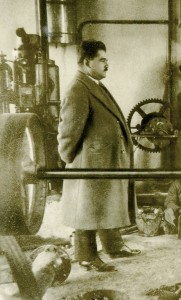
The first large commercial nursery was established by Giorgos Fourtounas in 1925. Fourtounas had bought fields in Aegina at Limbones. Wanting to develop them he approached the Professor of Aboriculture of the Higher Agronomic Faculty in Athens, Panos Anagnostopoulo. Anagnostopoulos advised him to plant pistachio trees. Fourtounas then establised a large plant nursery. At first the trees he raised he used to fill the needs of his own estate. Later on however, he sold plants to the landowners of Aegina and other areas in Greece, as well as giving them away to his friends. This was Fourtounas’ great gift to Aegina: the production of pistachio tree plants at the time of an increase in demand. In Aegina large tracts were planted with trees from the Fourtouna nursery, which was largely responsible for the spread of the pistachio tree on the island. After his death in 1939 the nursery continued to be run by his widow, Panagiota, until 1960.
The years 1930-1931. The first big epidemic
 Around 1930-31 pistachio trees were attacked by a small beetle. The damage was severe, the young vegetation was destroyed and the trees looked sickly. The Aeginitans called this new enemy “The borer” or “The blinder”.
Around 1930-31 pistachio trees were attacked by a small beetle. The damage was severe, the young vegetation was destroyed and the trees looked sickly. The Aeginitans called this new enemy “The borer” or “The blinder”.
The famous Florentine plant disease specialist Lionello Petri, to whom they sent samples of the damaged plants, decided that it was all due to an insect called Acrantus vestitus that attacks weakened trees.
The plant specialist Professor Yiannis Sareyiannis visited Aegina in the August of 1930 and in a relevant publication wrote that the pistachio trees were laden with nuts, but hadn’t produced any leaves. He found that the leafage had fallen because of the fungal disease Septoria. This was the cause of the weakening of the trees which had then led to the attack by the Acrantus vestitus beetle.
The Acrantus vestitus beetle can be got rid of without the use of chemicals. Basically. all the dry branches – where the beetle lays its eggs – must be gathered together throughout the year, and burned. Today the “The borer” or “blinder” is not much of a threat to the Aegina pistachios.
The 1930s – the establishment of nurseries
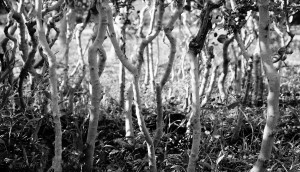 During the 1930s the spread of pistachio cultivation continued. Professor Panos Anagnostopoulos writes in his book: “The Pistachio Tree in Greece” (1935) of pistachio trees in Attica as well as in Aegina. Nikolis Haimandas, in the early 1930s had planted a large part of his land with pistachio trees, and they were already bearing fruit. At the end of the 1930s he established his first commercial nursery. He took on Dionysis Loukatos, a graduate of the Agricultural College, as his assistant. Haimandas sold saplings produced in Aegina as well as those from other parts of Greece. He also gave away plants to his workers to improve their earnings. He really believed that the pistachio was a potential source of wealth for the island, so much so that in his will he left orders that his heirs should continue his work.
During the 1930s the spread of pistachio cultivation continued. Professor Panos Anagnostopoulos writes in his book: “The Pistachio Tree in Greece” (1935) of pistachio trees in Attica as well as in Aegina. Nikolis Haimandas, in the early 1930s had planted a large part of his land with pistachio trees, and they were already bearing fruit. At the end of the 1930s he established his first commercial nursery. He took on Dionysis Loukatos, a graduate of the Agricultural College, as his assistant. Haimandas sold saplings produced in Aegina as well as those from other parts of Greece. He also gave away plants to his workers to improve their earnings. He really believed that the pistachio was a potential source of wealth for the island, so much so that in his will he left orders that his heirs should continue his work.
His sons continued with the pistachio tree nursery and as his son Andonis says, more than half the pistachio trees in Aegina came from the Haimanda nursery. The Haimanda family has been working with pistachio trees for over 60 years.
Pistachio tree nurseries were set up also by many other landowners. With the plants they produced, they firstly covered the needs of their own estates and then sold on what they didn’t need.
The 1940s – the war

Those who worked the land grew staple plants such as the potato. It seems unlikely that pistachio cultivation spread at all during this period, although those who produced pistachios could exchange them for other foods, or supplement their meagre diet.
In 1950, according to data from the National Statistical Service, the cultivation of pistachios covered 1,050 stremmata. It is believed that most of that land was planted after the end of the war.
The 1950s and 60s
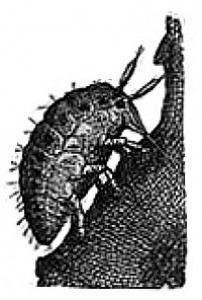 THE APPEARANCE OF PHYLLOCERA & THE GREAT INCREASE IN PISTACHIO FARMING
THE APPEARANCE OF PHYLLOCERA & THE GREAT INCREASE IN PISTACHIO FARMING
The increase in pistacio farming in Aegina came about during the ‘50s and ‘60s, when phylloxera struck the island’s vineyards. Phylloxera is a small insect which attacks the roots of European vines and dries out the leaves. Five years after its arrival in a vineyard, all the grapevines would wither.
In the early 1950s phylloxera appeared in Attica and the Ministry of Agriculture in an attempt to protect Aegina – whose primary product then was the grape – set up a plant disease control post in the harbour to stop the entry of any product onto the island which could harbour the insect (saplings etc). But these attempts to control the spread of the disease failed. We don’t know exactly when the insect started to make inroads into Aegina’s vineyards, but it was probably around the end of the 1950s.
On the infected vineyards the farmers then started to plant pistachio saplings among the vines so that when the vines had dried up they would have already established their new product.
The data shows that in 1950 there were 13,000 stremmata of vineyards which fell to 4,382 stremmata in 1961. The land under pistachio cultivation in 1961 was 3,200 stremmata against 1,050 stremmata in 1950.
The establishment of the agricultural cooperativeof Aegina pistachio producers
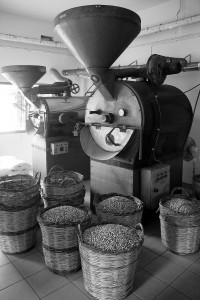 In 1947 the Aegina Agricultural Cooperative was founded. Nevertheless the archives of the Cooperative refer to activities already being undertaken by a small group inspired by Evangelo Marini, dating from around the time of the German Occupation of the island.
In 1947 the Aegina Agricultural Cooperative was founded. Nevertheless the archives of the Cooperative refer to activities already being undertaken by a small group inspired by Evangelo Marini, dating from around the time of the German Occupation of the island.
In November 1959 the “Aegina” newspaper published an article in which a suggestion was made to establish an Agricultural Cooperative of Aegina Pistachio Producers in an attempt to counter the exploitation of farmers by commercial traders.
In 1975 the Cooperative created a branch for pistachio farmers. In the General Assembly on 18th August 1996 its name was modified to the Agricultural Cooperative of Aegina Pistachio Producers – today it has 350 members.
The Cooperative’s goals are:
a) To intervene on behalf of Aegina’s pistachio producers in the subject of the product’s price
b) To control the distribution and processing of the Aegina pistachio.
From the 1970s to 1990
Pistachio cultivation continued to spread during the decades 1970 to 1990. The 1974 census refers to 4,200 stremmata. By the year 2000 this must have increased by at least 1,000 more stremmata.
Many people planted pistachio trees in Aegina, most of whom are not farmers. Some planted pistachio trees around their houses, others in small orchards and some in estates of tens of stremmata. It is not possible to find and mention their names in this article – that would be the work of a dissertation on the subject. However they all contributed to the distribution of the Aegina pistachio and an increase in the awareness of its high quality and excellent taste.
The Aegina Pistachio’ as protected designation of origin – P.D.O.
 In 1994 the Aegina Pistachio entered the lists of products with protected designation of origin (P.D.O.)
In 1994 the Aegina Pistachio entered the lists of products with protected designation of origin (P.D.O.)
The institution of products with protected designation of origin was a decision made by the European Union (EU) to protect the names of products from certain specified areas which are affected by illegal competitors using that name. The inclusion of the Aegina Pistachio as a product of protected designation of origin was ratified by the law P.D. 81/19.3.1993 after an application by the Aegina Agricultural Association after a presentation and proposal by the Farming Management Association of Pireaus, headed by the local agronomist Aristotelis Tekos, while the research into its economic expediency was made by the agronomist Michalis Moutsatsos.
According to the study, the reasons that the Aegina Pistachio was declared a product of Protected Designation of Origin, are:
The Aegina Pistachio is the product of a particular area as shown by its pan-Helladic fame and the name of the pistachio with the name of Aegina.
The Aegina Pistachio, due to a rare combination of factors, has an unique flavour which is what has made it famous.
The pistachio cultivation along with other factors has kept the population in Aegina, and there is no sign of the island becoming deserted like so many others.
In 1996 the Aegina Pistachio was registered as product of Protected Designation of Origin (P.D.O) in the EU’s official gazette.
